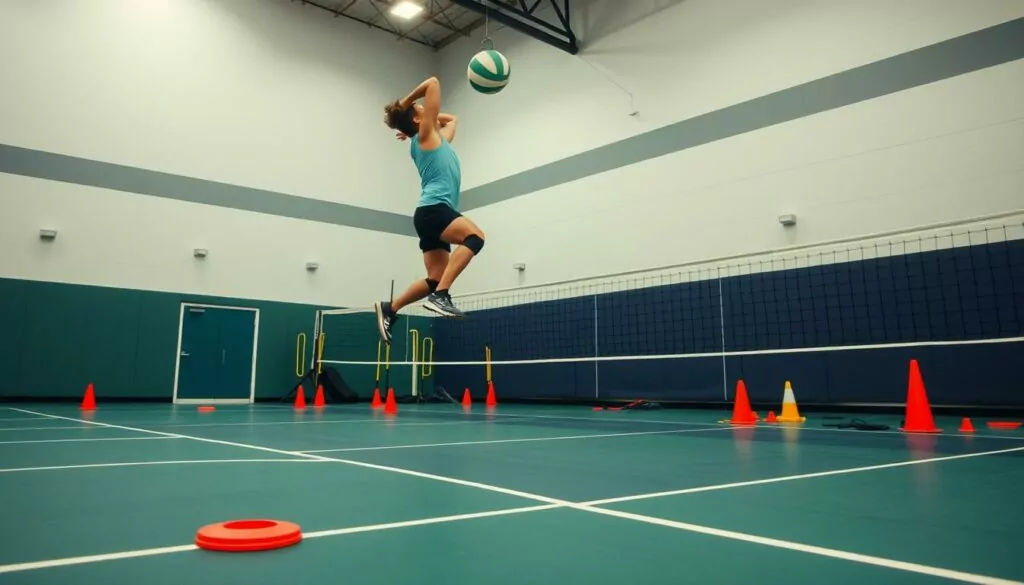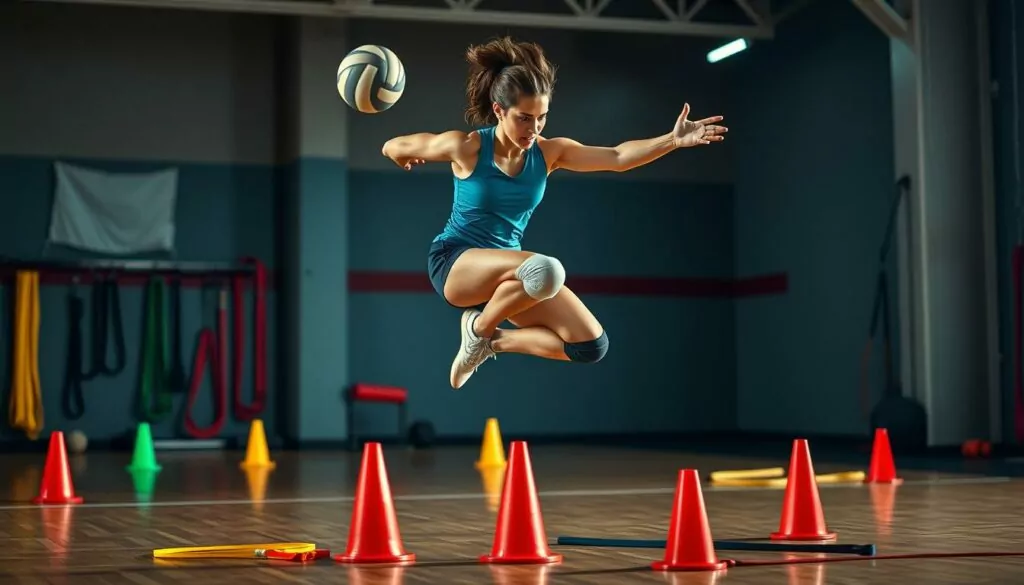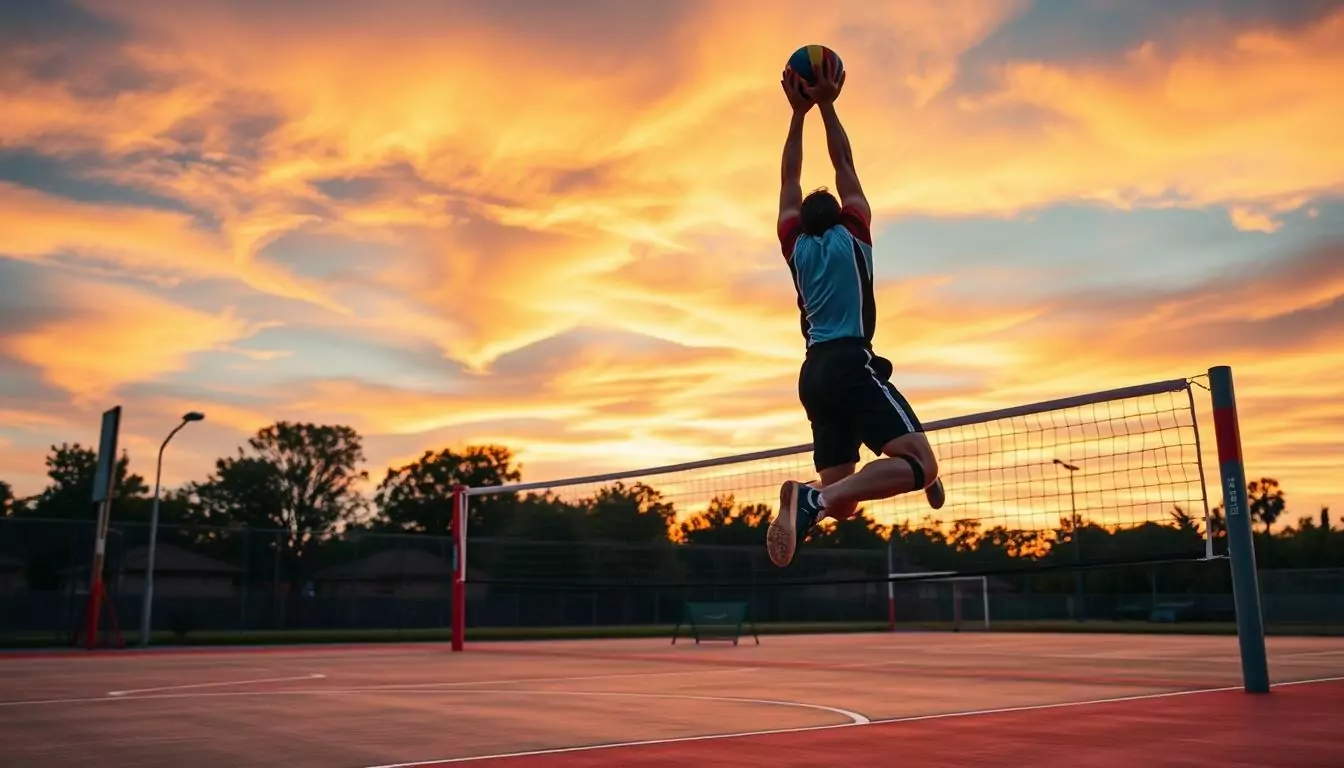I still remember the first time I soared above the net, my fingertips grazing the ball as I slammed it onto the opposite court. That exhilarating moment sparked my passion for improving my vertical jump for volleyball. It’s a journey I’ve been on ever since, constantly pushing my limits and seeking new ways to elevate my game.
In this guide, I’ll share my experiences and insights on volleyball conditioning and mastering explosive movements. Whether you’re a seasoned player or just starting out, I’m here to help you reach new heights – literally!
Key Takeaways
- Enhancing vertical jump is crucial for volleyball success
- Proper conditioning focuses on strength, power, and flexibility
- Explosive movements are key to improving jump height
- Consistent training and tracking progress lead to results
- A mix of exercises targets different aspects of jumping ability
- Setting realistic goals helps maintain motivation
Understanding the Importance of Vertical Jump in Volleyball

Vertical jump is a game-changer in volleyball. It’s not just about reaching new heights; it’s about dominating the court. As a player, I’ve learned that jumping mechanics play a crucial role in my performance.
Why Vertical Jump Matters for My Game
A powerful vertical leap gives me an edge in several aspects of play:
- Spiking: I can hit the ball at higher points, making it harder to block
- Blocking: I can reach above the net more effectively
- Serving: I gain better control and power on jump serves
The Mechanics of Jumping
Understanding jumping mechanics has transformed my approach to training. It involves three key phases:
- Loading: Bending knees and hips to store energy
- Exploding: Rapidly extending legs and swinging arms upward
- Landing: Absorbing impact to prevent injuries
By focusing on these phases in my vertical leap drills, I’ve seen significant improvements in my jump height.
How My Vertical Jump Affects Performance
My vertical jump directly impacts my overall performance on the court. Here’s a breakdown of how it influences different aspects of my game:
| Skill | Impact of Vertical Jump | Performance Improvement |
|---|---|---|
| Spiking | Higher contact point | Increased attack options |
| Blocking | Greater reach above net | Improved defensive coverage |
| Serving | Enhanced power and control | More aces and difficult returns |
By incorporating power development exercises into my routine, I’ve noticed a significant boost in my overall gameplay. It’s clear that a strong vertical jump is key to excelling in volleyball.
Key Exercises to Enhance My Vertical Leap

I’ve discovered that improving my vertical jump requires a mix of targeted exercises. Let’s dive into the key components that’ll help me soar higher on the volleyball court.
Strength Training for Jumping
Building leg strength is crucial for a powerful leap. I focus on these leg strength exercises:
- Squats: They target my quads, hamstrings, and glutes
- Deadlifts: Great for overall lower body strength
- Lunges: Help with single-leg power
- Calf raises: Essential for that final push-off
Plyometric Drills to Boost Power
Plyometric training is all about explosive movements. My favorite drills include:
- Box jumps: Enhance my explosive power
- Depth jumps: Improve my reactive strength
- Tuck jumps: Work on my core and leg coordination
Agility and Flexibility Routines
To round out my training and prevent injury, I incorporate:
- Agility ladder drills: Boost my footwork and coordination
- Dynamic stretching: Improves my flexibility and range of motion
- Yoga: Enhances overall body control and balance
By combining these exercises, I’m creating a well-rounded program to elevate my game. Remember, consistency and proper form are key to seeing results and staying injury-free.
| Exercise Type | Benefits | Frequency |
|---|---|---|
| Strength Training | Builds leg power, improves jump height | 2-3 times/week |
| Plyometrics | Increases explosive power, quicker takeoff | 1-2 times/week |
| Agility & Flexibility | Enhances coordination, reduces injury risk | 3-4 times/week |
Tracking My Progress and Staying Motivated
As I work on my vertical leap drills, it’s crucial to keep tabs on my improvement. This helps me stay on track and keeps my spirits high. Let’s dive into some effective ways to monitor my progress and stay pumped up throughout my volleyball conditioning journey.
Setting Realistic Goals for Improvement
I start by setting achievable targets for my vertical jump. By aiming for small, steady gains, I avoid feeling overwhelmed. I might aim to add an inch to my jump every month. This approach keeps me focused and motivated as I see myself getting closer to my goals.
Measuring My Vertical Jump Effectively
To track my progress accurately, I use simple but reliable methods. The chalk mark test is my go-to. I jump and mark the wall with chalk, then measure the difference from my standing reach. This gives me a clear picture of my jump technique improvements over time.
Celebrating Small Wins Along the Way
I make sure to acknowledge every bit of progress in my vertical leap drills. Even a half-inch gain is worth celebrating! These small victories fuel my motivation and remind me that my hard work in volleyball conditioning is paying off. By focusing on these wins, I stay committed to my training and keep pushing towards my ultimate vertical jump goals.
